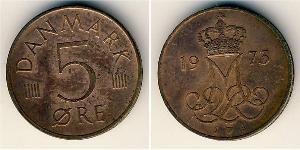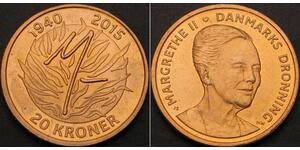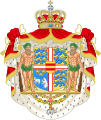| Margrethe II | |||||
|---|---|---|---|---|---|
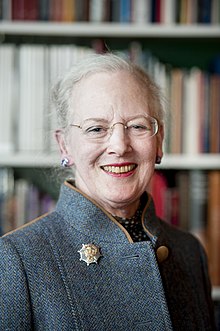 |
|||||
| Queen of Denmark (more...) | |||||
| Reign | 14 January 1972 – present | ||||
| Predecessor | Frederick IX | ||||
| Heir apparent | Crown Prince Frederik | ||||
| Prime Ministers |
Denmark
Faroe Islands
|
||||
| Spouse | Henrik, Prince Consort of Denmark (1967–present) | ||||
| Issue Detail |
Crown Prince Frederik Prince Joachim |
||||
|
|||||
| House | House of Glücksburg[1] | ||||
| Father | Frederick IX of Denmark | ||||
| Mother | Princess Ingrid of Sweden | ||||
| Born | 16 April 1940 Copenhagen, Denmark |
||||
| Religion | Lutheranism | ||||
| Signature | |||||
| Danish Royal Family |
|---|
 |
| HM The Queen HRH Princess Benedikte
Extended royal family
|
Margrethe II (Danish pronunciation: [mɑˈɡ̊ʁæːˀd̥ə], full name: Margrethe Alexandrine Þórhildur Ingrid; born 16 April 1940) is the Queen of Denmark. As the eldest child of King Frederick IX and Ingrid of Sweden, she succeeded her father upon his death on 14 January 1972. On her accession, she became the first female monarch of Denmark since Margrethe I, ruler of the Scandinavian countries in 1375–1412 during the Kalmar Union. Having been on the Danish throne for 43 years, she is currently the longest-reigning of the three Scandinavian monarchs (Sweden's Carl XVI Gustaf has reigned since 1973 and Norway's Harald V has reigned since 1991). She is one of two queens regnant currently on the throne along with Queen Elizabeth II of the United Kingdom.
Margrethe was born in 1940, but did not become heir presumptive until 1953, when a constitutional amendment allowed women to inherit the throne (after it became clear that King Frederick was unlikely to have any male issue). In 1967, she married Henri de Laborde de Monpezat, with whom she has two sons: Crown Prince Frederik (born 1968) and Prince Joachim (born 1969).
Contents
Early life[edit]
Princess Margrethe was born 16 April 1940 at Amalienborg Palace in Copenhagen as the first child of Crown Prince Fredrcik, later King Frederick IX and Crown Princess Ingrid, later Queen Ingrid. Her father was the eldest son of the then-reigning King Christian X, while her mother was the only daughter of Crown Prince Gustaf Adolf, later King Gustaf VI Adolf of Sweden, and Crown Princess Margaret, an granddaughter of Queen Victoria. Her birth took place just one week after Nazi Germany's invasion of Denmark on 9 April 1940.[2]
She was baptised 14 May 1940 in the Church of Holmen in Copenhagen.[2] The Princess's godparents were: her paternal grandfather, King Christian X; her paternal uncle, Hereditary Prince Knud; her cousin, Prince Axel; her maternal great-grandfather, King Gustaf V of Sweden; her maternal grandfather, Crown Prince Gustaf Adolf of Sweden; her maternal uncle, Prince Gustaf Adolf, Duke of Västerbotten; and her maternal great-grandfather, Prince Arthur, Duke of Connaught and Strathearn.
She was named Margrethe after her maternal grandmother, Crown Princess Margaret of Sweden, Alexandrine after her paternal grandmother, Queen Alexandrine, and Ingrid after her mother, Crown Princess Ingrid. Since her paternal grandfather was also the King of Iceland, and Margrethe until 1944 was an Icelandic princess, she was given an Icelandic name, Þórhildur (Thorhildur).[3]
When Margrethe was four years old, in 1944, her first sister, Princess Benedikte, was born. Princess Benedikte later married Prince Richard of Sayn-Wittgenstein-Berleburg and lives some of the time in Germany. Her second sister Princess Anne Marie was born in 1946. Anne-Marie later married Constantine II of Greece and now lives in London.
On 20 April 1947, King Christian X died and Margrethe's father ascended the throne as King Frederick IX.
Heir presumptive[edit]
At the time of her birth, only males could ascend the throne of Denmark, owing to the changes in succession laws enacted in the 1850s when the Glücksburg branch was chosen to succeed. As she had no brothers, it was assumed that her uncle Prince Knud would one day assume the throne.
The process of changing the constitution started in 1947, not long after her father ascended the throne and it became clear that Queen Ingrid would have no more children. The popularity of Frederick and his daughters and the more prominent role of women in Danish life started the complicated process of altering the constitution. The law required that the proposal be passed by two successive Parliaments and then by a referendum, which occurred 27 March 1953. The new Act of Succession permitted female succession to the throne of Denmark, according to male-preference cognatic primogeniture, where a female can ascend to the throne only if she does not have a brother. Princess Margrethe therefore became heir presumptive.[2]
On her eighteenth birthday, 16 April 1958, Margrethe was given a seat in the Council of State. She subsequently chaired the meetings of the Council in the absence of the King.[2]
In 1960, together with the princesses of Sweden and Norway, she travelled to the United States, which included a visit to Los Angeles, California, and to the Paramount Studios, where they were met by several celebrities, including Dean Martin, Jerry Lewis and Elvis Presley.[4]
Education[edit]
Margrethe was educated at the private school N. Zahle's School in Copenhagen from which she graduated in 1959. She spent a year at North Foreland Lodge, a boarding school for girls in Hampshire, England,[5] and later studied prehistoric archaeology at Girton College, Cambridge, during 1960–1961, political science at Aarhus University between 1961 and 1962, attended the Sorbonne in 1963, and was at the London School of Economics in 1965.[6] She is a Fellow of the Society of Antiquaries of London.[2]
Queen Margrethe is fluent in Danish, French, English, Swedish and German, and has a limited knowledge of Faroese.[2][6]
Marriage[edit]
Princess Margrethe married a French diplomat, Count Henri de Laborde de Monpezat, 10 June 1967, at the Church of Holmen in Copenhagen. Laborde de Monpezat received the style and title of "His Royal Highness Prince Henrik of Denmark" because of his new position as the spouse of the heir presumptive to the Danish throne.[2]
Margrethe gave birth to her first child 26 May 1968. By tradition, the Danish King was alternately named either Frederick or Christian. She chose to maintain this by assuming the position of a Christian, and thus named her eldest son Frederik. A second child, named Joachim, was born 7 June 1969.[2]
Reign[edit]
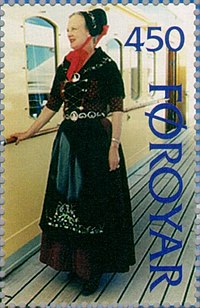
Succession[edit]
Shortly after King Frederick IX had delivered his New Year's Address to the Nation at the 1971/72 turn of the year, he fell ill. At his death 14 days later 14 January 1972, Margrethe succeeded to the throne, becoming the first female Danish sovereign under the new Act of Succession. She was proclaimed Queen from the balcony of Christiansborg Palace 15 January 1972, by Prime Minister Jens Otto Krag. Queen Margrethe II relinquished all the monarch's former titles except the title to Denmark, hence her style By the Grace of God, Queen of Denmark (Danish:Margrethe den Anden, af Guds Nåde Danmarks Dronning). The Queen chose the motto: God's help, the love of The People, Denmark's strength.[6]
In her first address to the people, Queen Margrethe II said:
"My beloved father, our King, is dead. The task that my father had carried for nearly 25 years is now resting on my shoulders. I pray to God to give me help and strength to carry the heavy heritage. May the trust that was given to my father also be granted to me."[7]
Constitutional role[edit]
The Queen's main tasks are to represent the Kingdom abroad and to be a unifying figurehead at home. She receives foreign ambassadors and awards honours and medals. The Queen performs the latter task by accepting invitations to open exhibitions, attending anniversaries, inaugurating bridges, etc.
As an unelected public official, the Queen takes no part in party politics and does not express any political opinions. Although she has the right to vote, she opts not to do so to avoid even the appearance of partisanship.[2]
After an election where the incumbent Prime Minister does not have a majority behind him or her, the Queen holds a “Dronningerunde” (Queen's meeting) in which she meets the chairmen of each of the Danish political parties.[8]
Each party has the choice of selecting a Royal Investigator to lead these negotiations or alternatively, give the incumbent Prime Minister the mandate to continue his government as is. In theory each party could choose its own leader as Royal Investigator, the social liberal Det Radikale Venstre did so in 2006, but often only one Royal Investigator is chosen plus the Prime Minister, before each election. The leader who, at that meeting succeeds in securing a majority of the seats in the Folketing, is by royal decree charged with the task of forming a new government. (It has never happened in more modern history that any party has held a majority on its own.)
Once the government has been formed, it is formally appointed by the Queen. Officially, it is the Queen who is the head of government, and she therefore presides over the Council of State, where the acts of legislation which have been passed by the parliament are signed into law. In practice, however, nearly all of the Queen's formal powers are exercised by the Council of State, and she is required by convention to act on its advice.
In addition to her roles in her own country, the Queen is also the Colonel-in-Chief of the Princess of Wales's Royal Regiment (Queen's and Royal Hampshires), an infantry regiment of the British Army, following a tradition in her family.[2]
Ruby Jubilee[edit]
Queen Margrethe II celebrated her Ruby Jubilee, the 40th year on the throne, 14 January 2012.[9] This was marked by a carriage procession, and numerous TV interviews.
Personal life and interests[edit]
The official residences of the Queen and the Prince Consort are Amalienborg Palace in Copenhagen and Fredensborg Palace. Their summer residence is Gråsten Palace near Sønderborg, the former home of the Queen's mother, Queen Ingrid, who died in 2000.
Margrethe is an accomplished painter, and has held many art shows over the years. Her illustrations—under the pseudonym Ingahild Grathmer—were used for the Danish edition of The Lord of the Rings, which she was encouraged to illustrate in the early 1970s. She sent them to J.R.R. Tolkien who was struck by the similarity of her drawings to his own style. Margrethe's drawings were redrawn by the British artist Eric Fraser in the translation published in 1977 and re-issued in 2002. In 2000, she illustrated Henrik, the Prince Consort's poetry collection Cantabile. She is also an accomplished translator and is said to have participated in the Danish translation of The Lord of the Rings.[6] Another skill she possesses is costume designing, having designed the costumes for the Royal Danish Ballet's production of A Folk Tale and for the 2009 Peter Flinth film, De vilde svaner (The Wild Swans).[2][10] She also designs her own clothes and is known for her colourful and sometimes eccentric clothing choices. Margrethe also wears designs by former Pierre Balmain designer Erik Mortensen, Jørgen Bender, and Birgitte Taulow.[11] She was listed as one of the fifty best-dressed over 50s by The Guardian in March 2013.[12]
Margrethe is a chain smoker, and she is famous for her tobacco habit.[13] However, on 23 November 2006 the Danish newspaper B.T. reported an announcement from the Royal Court stating that in future the Queen would smoke only in private.[14]
A statement in a 2005 authorized biography about the Queen (entitled Margrethe) focused on her views of Islam: "We are being challenged by Islam these years. Globally as well as locally. There is something impressive about people for whom religion imbues their existence, from dusk to dawn, from cradle to grave. There are also Christians who feel this way. There is something endearing about people who give themselves up completely to their faith. But there is likewise something frightening about such a totality, which also is a feature of Islam. A counterbalance has to be found, and one has to, at times, run the risk of having unflattering labels placed on you. For there are some things for which one should display no tolerance. And when we are tolerant, we must know whether it is because of convenience or conviction."[15]
Godchildren[edit]
The Queen is a godmother to:
- Ellen Hillingsø (born 9 March 1967)
- His Majesty The King of the Netherlands (Willem-Alexander Claus George Ferdinand; born 27 April 1967)
- His Royal Highness Prince Carl Philip, Duke of Värmland (Carl Philip Edmund Bertil of Sweden; born 13 May 1979)
- Her Royal Highness Princess Theodora of Greece and Denmark (born 9 June 1983)
Family[edit]
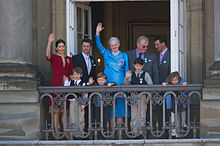
The Queen and The Prince Consort have two sons and eight grandchildren:
- His Royal Highness Crown Prince Frederik André Henrik Christian of Denmark (born 26 May 1968). He was married to Mary Donaldson on 14 May 2004 at Copenhagen Cathedral, Copenhagen. The couple has four children:
- His Royal Highness Prince Christian Valdemar Henri John of Denmark (born 15 October 2005)
- Her Royal Highness Princess Isabella Henrietta Ingrid Margrethe of Denmark (born 21 April 2007)
- His Royal Highness Prince Vincent Frederik Minik Alexander of Denmark (born 8 January 2011)
- Her Royal Highness Princess Josephine Sophia Ivalo Mathilda of Denmark (born 8 January 2011)
- His Royal Highness Prince Joachim Holger Waldemar Christian of Denmark (born 7 June 1969). He was married to Alexandra Manley on 18 November 1995 at Frederiksborg Palace Church, Hillerød. They divorced on 8 April 2005. He was married secondly to Marie Cavallier on 24 May 2008 at Møgeltønder Church, Møgeltønder. Joachim has four children:
- His Highness Prince Nikolai William Alexander Frederik of Denmark (born 28 August 1999)
- His Highness Prince Felix Henrik Valdemar Christian of Denmark (born 22 July 2002)
- His Highness Prince Henrik Carl Joachim Alain of Denmark (born 4 May 2009)
- Her Highness Princess Athena Marguerite Françoise Marie of Denmark (born 24 January 2012)
In 2008, the Queen announced that her male-line descendants would bear the additional title of Count of Monpezat, in recognition of her husband's claim to the comital title.[16]
Honours and decorations[edit]

See also : List of honours of the Danish Royal Family by country
She is the 1,188th Dame of the Order of the Golden Fleece in Spain, and the 961st Knight/Lady of the Order of the Garter and Colonel-in-Chief of the The Princess of Wales's Royal Regiment (Queen's and Royal Hampshires) in United Kingdom.
Danish decorations[edit]
 Order of the Elephant
Order of the Elephant Royal Family Order of Frederick IX of Denmark
Royal Family Order of Frederick IX of Denmark Grand Commander of the Order of the Dannebrog
Grand Commander of the Order of the Dannebrog One hundred anniversary Commemorative Medal of King Frederik IX's birth
One hundred anniversary Commemorative Medal of King Frederik IX's birth One hundred anniversary Commemorative Medal of King Christian X's birth
One hundred anniversary Commemorative Medal of King Christian X's birth Queen Ingrid's Commemorative Medal
Queen Ingrid's Commemorative Medal Commemorative Medal for the 50-year anniversary of Her Majesty Queen Ingrid's arrival in Denmark
Commemorative Medal for the 50-year anniversary of Her Majesty Queen Ingrid's arrival in Denmark Home Guard fortjensttegn
Home Guard fortjensttegn Home Guard 25-year mark
Home Guard 25-year mark Civil Defense League glory sign
Civil Defense League glory sign Danish Reserve Officers Association Medal
Danish Reserve Officers Association Medal
Greenlandic decorations[edit]
 Medal of Merit of Greenland Nersornaat
Medal of Merit of Greenland Nersornaat
Foreign decorations[edit]
 Argentina: Grand Cross of the Order of the Liberator San Martín
Argentina: Grand Cross of the Order of the Liberator San Martín Austria: Grand Star of the Decoration for Services to the Republic of Austria (1964)[17]
Austria: Grand Star of the Decoration for Services to the Republic of Austria (1964)[17] Belgium: Grand Cordon of the Order of Leopold (Belgium)[18]
Belgium: Grand Cordon of the Order of Leopold (Belgium)[18] Brazil: Grand Collar of the Order of the Southern Cross
Brazil: Grand Collar of the Order of the Southern Cross Bulgaria: Grand Cross with Cordon of the Order of the Stara Planina
Bulgaria: Grand Cross with Cordon of the Order of the Stara Planina Chile: Collar of the Order of the Merit of Chile
Chile: Collar of the Order of the Merit of Chile Croatia: Grand Order of King Tomislav
Croatia: Grand Order of King Tomislav Estonia: Collar of the Order of the Cross of Terra Mariana
Estonia: Collar of the Order of the Cross of Terra Mariana United Arab Emirates: Collar of the Order of Al Kamal
United Arab Emirates: Collar of the Order of Al Kamal Egypt: Collar of the Order of the Nile
Egypt: Collar of the Order of the Nile Finland: Grand Cross with Collar of the Order of the White Rose
Finland: Grand Cross with Collar of the Order of the White Rose France: Grand Cross of the Legion of Honour
France: Grand Cross of the Legion of Honour Germany: Grand Cross Special Class of the Order of Merit of the Federal Republic of Germany
Germany: Grand Cross Special Class of the Order of Merit of the Federal Republic of Germany Greece: Grand Cross of the Order of the Redeemer
Greece: Grand Cross of the Order of the Redeemer Greece: Grand Cross of the Order of Saints Olga and Sophia
Greece: Grand Cross of the Order of Saints Olga and Sophia Iceland: Grand Cross (1958) with Collar (1973) of the Order of the Falcon[19]
Iceland: Grand Cross (1958) with Collar (1973) of the Order of the Falcon[19] Iran: Order of the Pleiades, 2nd Class
Iran: Order of the Pleiades, 2nd Class Italy: Dame Grand Cross with Collar of the Order of Merit of the Italian Republic
Italy: Dame Grand Cross with Collar of the Order of Merit of the Italian Republic Japan: Grand Cordon (1st Class) of the Order of the Precious Crown
Japan: Grand Cordon (1st Class) of the Order of the Precious Crown Japan: Collar of the Order of the Chrysanthemum
Japan: Collar of the Order of the Chrysanthemum Jordan: Collar of the Order of the Star of Jordan
Jordan: Collar of the Order of the Star of Jordan Yugoslavia: Grand Cross of the Order of the Yugoslav Star
Yugoslavia: Grand Cross of the Order of the Yugoslav Star Latvia: Commander Grand Cross with Chain of the Order of the Three Stars
Latvia: Commander Grand Cross with Chain of the Order of the Three Stars Lithuania: Grand Cross of the Order of Vytautas the Great (1996)[20]
Lithuania: Grand Cross of the Order of Vytautas the Great (1996)[20] Luxembourg: Knight of the Order of the Gold Lion of the House of Nassau
Luxembourg: Knight of the Order of the Gold Lion of the House of Nassau Mexico: Collar of the Order of the Aztec Eagle (2008)[21]
Mexico: Collar of the Order of the Aztec Eagle (2008)[21] Morocco: Grand Cross with Collar of the Order of Ouissam Alaouite
Morocco: Grand Cross with Collar of the Order of Ouissam Alaouite Netherlands: Knight Grand Cross of the Order of the Netherlands Lion
Netherlands: Knight Grand Cross of the Order of the Netherlands Lion Nepal: Nepal Pratap Bhaskara (Nepal Decoration of Honour)
Nepal: Nepal Pratap Bhaskara (Nepal Decoration of Honour) Norway: Grand Cross with Collar of the Order of St. Olav
Norway: Grand Cross with Collar of the Order of St. Olav Poland: Knight of the Order of the White Eagle
Poland: Knight of the Order of the White Eagle Poland: Grand Cordon of the Order of Merit of the Republic of Poland
Poland: Grand Cordon of the Order of Merit of the Republic of Poland Portugal: Grand Collar of the Order of Prince Henry
Portugal: Grand Collar of the Order of Prince Henry Portugal: Grand Collar of the Order of Saint James of the Sword
Portugal: Grand Collar of the Order of Saint James of the Sword Romania: Collar of the Order of the Star of Romania
Romania: Collar of the Order of the Star of Romania Saudi Arabia: Collar of the Order of Abdulaziz al Saud
Saudi Arabia: Collar of the Order of Abdulaziz al Saud Slovakia: First Class (Grand Cross) of the Order of the White Double Cross[22]
Slovakia: First Class (Grand Cross) of the Order of the White Double Cross[22] Slovenia: Golden Order of Freedom of the Republic of Slovenia
Slovenia: Golden Order of Freedom of the Republic of Slovenia Spain: Knight of the Order of the Golden Fleece (1985)[23]
Spain: Knight of the Order of the Golden Fleece (1985)[23] Spain: Collar of the Order of Charles III (1980)[24]
Spain: Collar of the Order of Charles III (1980)[24] Sweden: Member with Collar of the Royal Order of the Seraphim
Sweden: Member with Collar of the Royal Order of the Seraphim Sweden: HM King Carl XVI Gustaf 50th Anniversary Medal (1996)[25]
Sweden: HM King Carl XVI Gustaf 50th Anniversary Medal (1996)[25] Sweden: Commemorative Ruby Jubilee Medal of His Majesty The King (2013)[26]
Sweden: Commemorative Ruby Jubilee Medal of His Majesty The King (2013)[26] South Africa: Grand Cross with Collar of the Order of Good Hope
South Africa: Grand Cross with Collar of the Order of Good Hope South Korea: Knight of Supreme Order of the Mugunghwa (Hibiscus)[27]
South Korea: Knight of Supreme Order of the Mugunghwa (Hibiscus)[27] Thailand: Knight of the Order of the Royal House of Chakri
Thailand: Knight of the Order of the Royal House of Chakri Thailand: Knight of the Order of the Rajamitrabhorn
Thailand: Knight of the Order of the Rajamitrabhorn United Kingdom: Lady of the Order of the Garter
United Kingdom: Lady of the Order of the Garter United Kingdom: Dame Grand Cross of the Royal Victorian Order
United Kingdom: Dame Grand Cross of the Royal Victorian Order United Kingdom: Recipient of the Royal Victorian Chain
United Kingdom: Recipient of the Royal Victorian Chain
Symbols of Margrethe II[edit]
16 April 1940 – 27 March 1953: Her Royal Highness Princess Margrethe of Denmark
27 March 1953 – 14 January 1972: Her Royal Highness Princess Margrethe, The Hereditary Princess of Denmark
14 January 1972 – present: Her Majesty Queen Margrethe II of Denmark
Ancestry[edit]
Patrilineal descent[edit]
| Patrilineal descent |
|---|
| Margrethe's patriline is the line from which she is descended father to son. Patrilineal descent is the principle behind membership in royal houses, as it can be traced back through the generations—which means that if Margrethe II were to choose an historically accurate house name it would be Oldenburg.
|
See also[edit]
References[edit]
- ^ "150 years of the House of Glücksborg". Retrieved 25 October 2014.
- ^ a b c d e f g h i j k "Her Majesty Queen Margrethe II". Kongehuset.dk. Retrieved 2014-12-11.
- ^ "Those Apprentice Kings and Queens Who May – One Day – Ascend a Throne". The New York Times. 14 November 1971.
- ^ "Elvis Presley with Princesses Margrethe of Denmark, Astrid of Norway, and Margaretha of Sweden". elvispresleymusic.com.au. 7 June 1960. Retrieved 2014-12-11.
- ^ The Illustrated London News 227 (2). 1955. p. 552. Missing or empty
|title=(help) - ^ a b c d "Margrethe and Henrik Biography". Royalinsight.net. 16 April 1940. Retrieved 3 February 2012.
- ^ "Queen Margrethe II of Denmark 40 years on the Throne". Radical Royalist. 13 January 2012. Retrieved 2014-12-11.
- ^ "The Monarchy today". Kongehuset.dk. Retrieved 2014-12-11.
- ^ "Queen Margrethe II of Denmark marks 40 years on the throne". BBC News. 12 January 2012.
- ^ "De vilde svaner (2009)". Internet Movie Database. Retrieved 2014-12-11.
- ^ "Flashback Friday: Queen Margrethe's Style". Orderofsplendor.blogspot.com. 13 January 2012. Retrieved 3 February 2012.
- ^ Cartner-Morley, Jess; Mirren, Helen; Huffington, Arianna; Amos, Valerie (28 March 2013). "The 50 best-dressed over 50s". The Guardian (Manchester).
- ^ Isherwood, Julian (23 March 2001). "Danish royals angry at cancer accusation". BBC News. Retrieved 2014-12-11.
- ^ Margrethe skruer ned for røgen at the Wayback Machine (archived October 16, 2007). bt.dk. 26 November 2006
- ^ Cleaver, Hannah (15 April 2005). "We need a counter-balance to Islam, says Danish queen". The Daily Telegraph (London). Retrieved 2014-12-11.
- ^ "Monpezat til Frederik og Joachim" [Monpezat for Frederik and Joachim]. Berlingske Tidende. 30 April 2008. Retrieved 2014-12-11.
- ^ "Bundeskanzler Anfragebeantwortung An die Präsidentin des Nationalrats" [Reply to a parliamentary question about the Decoration of Honour] (PDF) (in German). p. 168. Retrieved November 2012.
- ^ Photos: "Albert II & Margrethe II"."Group photo". Belga.
- ^ "Fálkaorðuhafar" [Holders of the Commander's Cross]. The President of Iceland. Retrieved 2014-12-11.
- ^ "Apdovanojimai" [Awards Database]. President of the Republic of Lithuania. Retrieved 2014-12-11.
- ^ "ACUERDO por el que se otorga a Su Majestad Margrethe II Reina de Dinamarca, la Condecoración de la Orden Mexicana del Aguila Azteca en el grado de Collar" [AGREEMENT that the Collar of the Order of the Aztec Eagle is awarded to Her Majesty Queen Margrethe II of Denmark]. Secretariat of the Interior. 13 February 2008. Retrieved 2014-12-11.
- ^ "Photo of the Danish Royal couple with the Slovakian Presidential couple". Kongehuset.dk.
- ^ "REAL DECRETO 1948/1985. de 23 de octubre. por el Que se concede el Collar de la Insigne Orden del Toisón de Oro a Su Majestad Margarita ll, Reina de Dinamarca" [Her Majesty Margrethe II, Queen of Denmark is awarded the Collar of the Illustrious Order of the Golden Fleece]. Boletín Oficial del Estado. 24 October 1985. Retrieved 2014-12-11.
- ^ "REAL DECRETO 738/1980, de 15 de marzo, por el que se concede el Collar de la Real y Muy Distinguida Orden de Carlos Ill a Su Majestad Margarita ll, Reina de Dinamarca" [Royal Decree 738/1980 of 15 March, granting the Collar of the Royal and Most Distinguished Order of Carlos III Margarita ll to Her Majesty, Queen of Denmark]. Boletín Oficial del Estado. 24 April 1980. Retrieved 2014-12-11.
- ^ "50th Anniversary Of King Carl Gustav Of Sweden In Stockholm, Sweden – News Photo". Gettyimages.ca. 30 April 1996. Retrieved 2014-12-11..
- ^ "Ruby Jubilee in Sweden" (in Spanish). Europapress.es. 16 September 2013. Retrieved 2014-05-07.
- ^ "Dîner de gala au Palais de Fredensborg" [Gala dinner at Fredensborg Palace]. Noblesse et Royautes. 13 May 2011. Retrieved 2014-12-11.
External links[edit]
| Wikimedia Commons has media related to Margrethe II. |
| Wikiquote has quotations related to: Margrethe II |
- The Queen's Homepage
- The Official Website of The Danish Monarchy
- Tapestries for HM The Queen of Denmark
|
Margrethe II
Born: 16 April 1940 |
||
| Regnal titles | ||
|---|---|---|
| Preceded by Frederick IX |
Queen of Denmark 1972–present |
Incumbent Heir apparent: Frederik |
| Lines of succession | ||
| Preceded by Countess Kajsa Bernadotte |
Line of succession to the British throne descended from Arthur, son of Victoria |
Succeeded by The Crown Prince of Denmark |
|
|||||||||||||||||||||||||||||||||
|
||||||||||||||||||||||||||||||||||||||||||||||||||||||||||||||||||
|
||||||||||||||||||||||
|
||||||
|
||||||||||||||||||||||||
|
- 1940 births
- Aarhus University alumni
- Alumni of Girton College, Cambridge
- Alumni of the London School of Economics
- Danish Lutherans
- Danish monarchs
- Danish people of Russian descent
- Danish people of Swedish descent
- Danish translators
- English–Danish translators
- Extra Ladies of the Order of the Garter
- Fellows of Girton College, Cambridge
- House of Glücksburg (Denmark)
- House of Monpezat
- Living people
- People educated at North Foreland Lodge
- People from Copenhagen
- Protestant monarchs
- Queens regnant
- Tolkien artists
- Translators to Danish
- Women translators
- Knights of the Royal Order of the Seraphim
- Collars of the Order of Abdulaziz al Saud
- Collars of the Order of Merit (Chile)
- Collars of the Order of the Aztec Eagle
- Collars of the Order of the Chrysanthemum
- Commanders Grand Cross with Collar of the Order of the White Rose of Finland
- Cordons of the Order of Stara Planina
- Dames of the Order of the Rajamitrabhorn
- Dames of the Order of the Royal House of Chakri
- Grand Collars of the Order of Prince Henry
- Grand Collars of the Order of Saint James of the Sword
- Grand Collars of the Order of the Southern Cross
- Grand Commanders of the Order of the Dannebrog
- Grand Cordons of the Order of Leopold (Belgium)
- Grand Cordons of the Order of Merit of the Republic of Poland
- Grand Cordons of the Order of the Precious Crown
- Grand Cordons of the Order of the Nile
- Grand Cordons of the Order of the Star of Jordan
- Grand Croix of the Légion d'honneur
- Grand Crosses of the Order of Good Hope
- Grand Crosses of the Order of Ouissam Alaouite
- Grand Crosses of the Order of the Liberator General San Martin
- Grand Crosses of the Order of the Redeemer
- Grand Crosses of the Order of the White Double Cross
- Grand Crosses of the Order of Vytautas the Great
- Grand Crosses with Collar of the Order of Charles III
- Grand Crosses with Collar of the Order of the Falcon
- Honorary Dames Grand Cross of the Royal Victorian Order
- Knights Grand Cross of the Order of the Netherlands Lion
- Knights Grand Cross with Collar of the Order of Merit of the Italian Republic
- Knights Grand Cross with Collar of the Order of St. Olav
- Knights of the Elephant
- Knights of the Golden Fleece
- Knights of the Order of the Gold Lion of the House of Nassau
- Members of Nepal Pratap Bhaskara
- Recipients of Nersornaat
- Recipients of the Collar of the Order of the Cross of Terra Mariana
- Recipients of the Grand Order of Mugunghwa
- Recipients of the Grand Star of the Decoration for Services to the Republic of Austria
- Recipients of the Order of Freedom of the Republic of Slovenia
- Recipients of the Order of the Three Stars, 1st Class with Chain
- Recipients of the Order of the White Eagle (Poland)
- Recipients of the Order of the Yugoslav Star
- Recipients of the Royal Victorian Chain
- Second Classes of the Order of the Pleiades (Iran)
- 20th-century women writers



